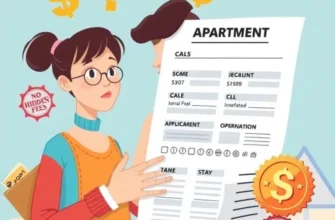Renting can feel like a rollercoaster ride—thrilling yet confusing. For young adults, first-time renters, or small families, the option to lease a home short-term offers a unique mixture of flexibility and uncertainty. But while it’s tempting to jump into a temporary lease and think, “What’s the worst that could happen?” knowing the pros and cons is key before making a leap into this renting frontier. Short-term leases can provide a safe haven while you figure out where you want to settle down, but they also come with their own set of quirks that you should be aware of. So, let’s dive into the implications of signing your name on a lease that only covers the next few months. Here’s what every first-time renter should consider!
The Bright Side: Pros of Short-Term Leases
Short-term leases offer a wealth of advantages, particularly appealing to young adults and families seeking flexibility in their living arrangements. One of the most significant benefits is the opportunity for personal and professional freedom. For those in dynamic careers or who are contemplating career shifts, short-term leases provide a grace period for exploring different cities or neighborhoods without the long-term commitment of a traditional lease.
Young adults, especially, can greatly benefit from this fluidity as it allows them to chase career opportunities or educational endeavors as they arise. Families, too, can find value in short-term leases, particularly if they are adjusting to rapidly changing circumstances such as relocation for a job, military deployment, or simply the pursuit of the best school districts. Having the ability to relocate without being tied to a lengthy contract provides significant peace of mind.
Moreover, short-term leases facilitate an easy entry into furnished apartments, eliminating the need for hefty investments in furniture and decor upon every move. This is particularly advantageous for young adults who may not yet have collected a full suite of home furnishings. Similarly, families in transition can benefit from not having to move large household items, making the relocation process less stressful.
Another notable advantage is the reduction of financial risk. Instead of committing to a year or longer when circumstances may change, leasing shorter-term accommodations allows tenants to have a clear and concise comparison of their expenses, especially relevant in fluctuating markets like renting in San Francisco. Tenants can maintain a degree of financial stability, knowing they can downsize or move to a more suitable location without penalty if their financial circumstances shift.
Short-term leases also inherently encourage new experiences. For young adults, this means the chance to live in diverse locales and immerse themselves in different cultural settings. Families can similarly enjoy exposure to varied environments, enriching their children’s perspectives and experiences. Consider the impact of exploring new communities, local attractions, parks, and educational facilities from a fresh vantage point every few months.
Perhaps most appealing for any renter is the convenience factor. Short-term leases streamline the decision-making process involved in renewing a lease or searching for permanent housing. This is ideal for those who need temporary housing while waiting for a house to be built or simply evaluating their long-term plans.
While short-term leases present numerous benefits, it is crucial to weigh these against individual needs and goals. For those able and willing to embrace change, they might just open up a realm of opportunities and experiences that otherwise would remain unexplored.
Exploring diverse housing options can provide significant insights into your personal preferences and geographic desires. In doing so, short-term rentals serve as a temporary canvas upon which renters can paint their evolving life stories with vibrant and adventurous new experiences.
The Dark Side: Cons of Short-Term Leases

While short-term leases offer flexibility and convenience, they also come with a slew of challenges that can disrupt both your peace of mind and your wallet. Understanding these potential drawbacks can help you make a more informed decision.
First and foremost, financial instability is a significant concern. Short-term leases often come with premium rental rates. Landlords and property managers charge higher monthly rents because turnover is more frequent, leading to increased costs for maintenance and marketing. Young adults and families on tight budgets might struggle to manage these expenses, especially in urban areas where renting is already expensive.
Another factor to consider is the lack of security. Short-term leases provide little in the way of long-term housing stability. Renters might find themselves having to move repeatedly, leading to not only financial strain but also emotional stress. Constantly searching for new accommodations can be exhausting, and finding suitable housing on short notice can be difficult, especially in high-demand markets.
The frequent moving associated with short-term leases can also disrupt family life and the sense of community. Young families, in particular, may find this a hurdle as consistency in living environments is often a key element of a stable upbringing. Establishing a routine becomes challenging when your address is constantly changing, and that fleeting sense of community can leave both individuals and families feeling isolated over time.
It’s also important to consider the difficulty of customization. Unlike long-term rentals, which often allow for more personalization, short-term leases usually have stricter restrictions on modifications. This can make it hard to create a living space that feels truly like home, which can be challenging for those who value a personalized environment.
Another significant downside is the potential impact on education for families with children. Frequent moves can mean changes in school districts, which disrupts schooling and social activities. This is often detrimental to a child’s educational progress and social development. The lack of continuity can also hinder participation in extracurricular activities or long-term projects.
Finally, there is often a lack of negotiating power when it comes to lease terms. Short-term renters usually have less leverage to negotiate favorable conditions or improvements. This is mostly because landlords are confident in their ability to find other tenants willing to pay premium prices due to the short lease periods.
Before diving into a short-term lease, you should weigh these downsides carefully. Consider if the flexibility and convenience are truly worth the potential financial strain and instability. If you’re curious about navigating different rental types, visiting this guide on renting in San Francisco might be insightful as it addresses the unique challenges of one of the most competitive rental markets.
Final words
In short, short-term leases can cater to a nomadic lifestyle or those seeking flexibility without long-term commitments. However, it’s essential to weigh the pros and cons before signing on the dotted line. Costs can stack up, and the feeling of uncertainty can sometimes overshadow the thrill of temporary living. Be realistic about your situation and consider how often you might have to move, how much it’s worth to you, and whether you are truly ready for the rollercoaster ride of short-term renting. So before you leap, take a moment to reflect: What kind of experience are you really looking for?









